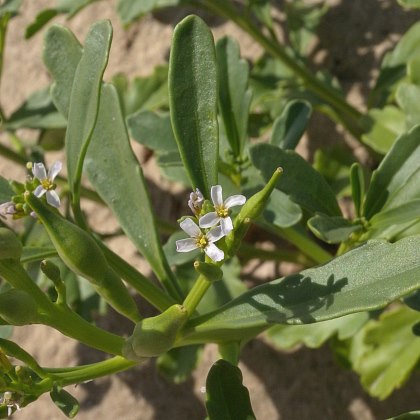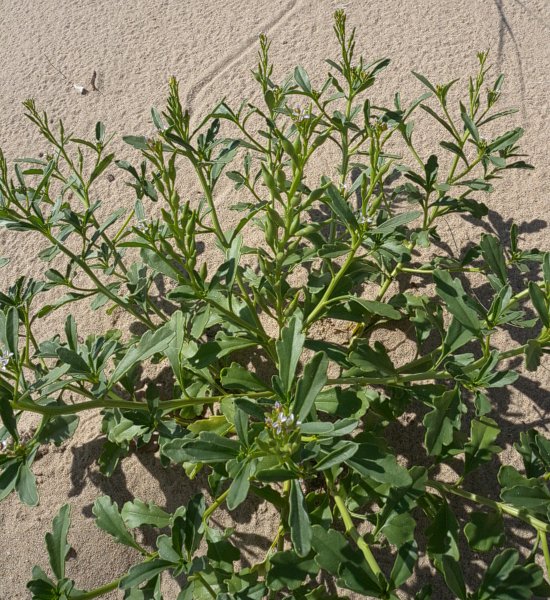
The blooming period occurs from mid-summer into the fall, lasting about 3 months. Only a few flowers are in bloom at the same time toward the apex of the racemes. The flowers are replaced by elongated seedpods (silicles) about ½-¾" long. Each seedpod has a lower segment (up to ¼" long) that is ovoid-cylindrical in shape, and an upper segment (up to ½" long) that is lanceoloid with a long tapering beak. Between these two segments, the seedpod is slightly constricted. The upper segment contains a single seed, while the lower segment contains either a single seed or none. At maturity, the upper segment of each seedpod becomes detached from the lower segment, while the lower segment persists on the dried remains of the plant. The upper segment can float on water, and it is often carried off by the waves of the lake or sea. Eventually, the upper segment is deposited at another beach, thereby introducing its seed to a new area. The seed of the lower segment usually germinates in proximity to its mother plant, colonizing the same beach.
Cultivation: The preference is full sun, moist to dry-mesic conditions, and very sandy soil. This plant also adapts to gravelly or rocky shorelines.

Range & Habitat: The native Sea Rocket is a rare plant in Illinois that is state-listed as 'threatened.' Its distribution is restricted to the shoreline of Lake Michigan in the NE section of the state (see Distribution Map). Habitats consist of sandy beaches and, to a lesser extent, gravelly or rocky shorelines. Outside of the state, Sea Rocket can be found along the shore lines of other Great Lakes (except the northernmost areas); a closely related subspecies of Sea Rocket is also found along the Atlantic coast.
Faunal Associations: Very little is known about floral-faunal relationships for this plant. Similar to other flowering plants in the Mustard family, Sea Rocket's flowers are probably cross-pollinated by small bees, flies, beetles, and small to medium-sized butterflies. There is a native flea beetle, Phyllotreta chalybeipennis, that feeds primarily, if not exclusively, on the foliage of Sea Rocket: its larvae form mines through the leaves. Other flea beetles that feed on the foliage of this plant include Phyllotreta crucifera (introduced from Europe), Phyllotreta punctulata, and Phyllotreta striolata (Clark et al., 2004). Larvae of a moth, the Rubbed Dart (Euxoa detersa), also referred to as the Sandhill Cutworm, feed primarily on the underground parts of Sea Rocket and many other plants in sandy areas (Covell, 1984/2005).

Photographic Location: A sandy beach at Indiana Dunes State Park in NW Indiana.
Comments: This member of the Mustard family is quite unique and easy to identify: it has slightly succulent leaves and unusual seedpods with 2 segments. Sea Rocket is a pioneer species of sandy beaches, colonizing areas that only a few plant species can tolerate. Because its succulent leaves can store water, it is able to withstand the desiccating effect of sunlight and sand. The root system helps to bind and stabilize the sand, while the decayed remnants of foliage add organic material and nutrients to the impoverished soil. This enables other plants to colonize the beach, beginning the process of ecological succession.